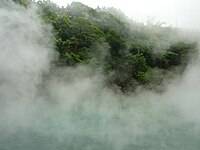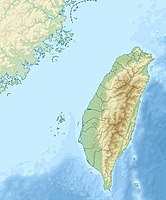 | ||
| Beitou | ||
| province | ||
|---|---|---|
| Republic of China has no parent region. | ||
| Residents | 256.766 (2017) | |
| height | 323 m | |
| no tourist info on Wikidata: | ||
| location | ||
| ||
Beitou (北投 區) is a municipality of Taipei and known for its hot springs.

background
Hundreds of years ago people in the region of today's Taipei knew a place where no trees grow and the earth is boiling. The natives called the place Patauw, home of the witches, due to the strong smell and fog. Over time, Patauw became Beitou. In 1894 a German explorer named Ouely found the place and started selling sulfur from Beitou. During the Japanese occupation, it was the Japanese businessman Hirata Gengo who built the first hot spring hotel in Beitou. In 1913, the first public bath based on the Izu Onsen was built in Japan. The place was connected to the railway network to bring tourists to Beitou. The Japanese influences can still be seen today. In the 1950s, the region served as the setting for many Taiwanese films.
Beitou lies between the Datun volcanic group and the edge of the Taipei Basin. Although the Datun volcanoes are dormant, there are signs of volcanic activity throughout the area, such as the hot springs and hydrogen sulphide eruptions. The water of the hot springs in Beitou is very sulphurous and also contains iron and traces of radon. In Beitou there is a globally unique barium sulfate crystal variation, the hokutolite.
getting there
With the Taipei MRT (Tamsui Line) to Beitou, then change to the bath train to Xinbeitou.
Tourist Attractions
- Beitou Park. The park forms the heart of Beitou. It was completed in 1913 and is located along the Beitou River. At the edge of the park there are large hotel complexes and opportunities for bathing in the hot springs. In the park itself there are various other sights, a public bath and the library. The Beitou River has a temperature of 35 ° C and is accessible for a small foot bath at some points.
- "Hot Spring Museum", No. 2, Zhongshan Rd, Beitou Dist. (KMT Beitou (red line)). Tel.: 886 2 2893 9981. In the adjacent "Höllental" there are several hot springs, most of which are built over by corresponding hotels. They were developed at the time of the Japanese administration. The museum was created from the remains of the first public bath in Beitou. It gives a nice overview of the history and bathing culture of Beitou. For those interested in science, there is a deeper insight into the geology and chemistry of the region and the hot springs.Open: Tue-Sun 9.00-17.00.Price: free entry.
- It's just a hundred meters from the previous one 1 Ketagalan Culture Center, No. 3-1, Zhongshan Rd, Beitou Dist. where is informed about Taiwanese Aboriginals.Open: Tue-Sun, 9 a.m.-5 p.m.
- Plum garden. The Plum Garden is a Japanese style country house built in 1930. One of the most famous residents of the house was Yu Youren, one of the greatest calligraphers in modern China. In the house you will find an exhibition about Youren's work and his political activities with the Kuomintang. When entering you have to take off your shoes and put on slippers.Open: daily except Mon.Price: free entry.
- Puji temple. The Puji Temple is a bit hidden between the hotel complexes on a small mountain slope. Built in 1905, it is a rare example of the temple architecture of the Buddhist Shingon sect, the Japanese Vajrana Buddhism. The design is based on the buildings of the Japanese Edo period.
- Thermal Valley. The Thermal Valley also called Hell Valley is the main attraction in Beitou. On an area of 3500 square meters there are various hot springs that feed a small lake. The water temperature averages 90 ° C and the water with a high sulfur content has a pH value of 1 when it emerges and is therefore more sulfuric acid than water. The lake itself makes a spectacular sight when the steam rises from the lake. Depending on the weather and temperature, this spectacle is more or less impressive. When crossing the small bridges one should watch out for the hot steam. Entering the lake is prohibited. At the edge of the lake you will find various signs on how to give first aid if someone falls into the lake.
 Hot Spring Museum |  Thermal Valley |  Beitou Park |  Puji temple |
activities
Hot springs, SPA and everything that has to do with it. Each hotel has its own baths and there are public and private bathing establishments. The hot water from the springs is brought to the hotels centrally by a pipe system.
kitchen
There are a lot of Japanese restaurants, but also some Chinese ones. A specialty are the guandula duck eggs, which are cooked in the hot springs.
accommodation
There are a variety of hotels and spas, almost all in the upper price range.
literature
Web links
https://btdo.gov.taipei/ - Beitou official website

